Best cheap camera for YouTube videos
August 3 2012, updated Nov 2013

Older cameras, 640x480 video
 I have often been asked which camera I use for videos. The answer
to that question varies over time. I can't really say which camera is best,
but I can tell you what my experience has been. I'm still looking for
the perfect cheap camera. Professional gear would surely be better,
but I prefer the low commitment of inexpensive cameras.
I have often been asked which camera I use for videos. The answer
to that question varies over time. I can't really say which camera is best,
but I can tell you what my experience has been. I'm still looking for
the perfect cheap camera. Professional gear would surely be better,
but I prefer the low commitment of inexpensive cameras.
At left, several cameras that I used up until the start of 2010. These all shoot 640x480. 640x480 is almost as good as the old standard definition NTSC TV, but quality standards have improved since.
A sample video I shot at 640x480: Building bandsaw experiments
Samsung WB550
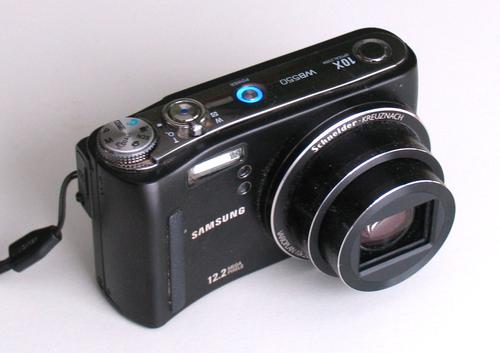 By the start of 2010, I figured I should switch to high definition.
So I bought the Samsung WB550, on sale for $300. That camera could do 720p HD
video. At that time, HD video was rare in cheap cameras.
By the start of 2010, I figured I should switch to high definition.
So I bought the Samsung WB550, on sale for $300. That camera could do 720p HD
video. At that time, HD video was rare in cheap cameras.
The camera was a big improvement over 640x480. It also had very good audio. It could also zoom out to 24 mm equivalent - very wide angle. That comes in very handy when filming indoors with limited space, which is what I mostly do.
But the camera performed poorly in low light, and it also introduced the occasional audio glitch. The camera claims to have image stabilization, but as far as I could tell, it either didn't work or made no difference.
But for a while, I was content with this camera. I shot a lot of videos with it.
Sample video shot with the WB550: Pen shaking contraption
Canon SD780 IS
 Later in 2010, I played with my sister's Canon SD780 IS. It's a tiny little
camera, but I found that even though the video was 720p, like the Samsung,
the quality was much better, especially under low light. It also has
working image stabilization, handy for video.
It only cost $200 + tax, and was very pocketable. So I bought one.
Later in 2010, I played with my sister's Canon SD780 IS. It's a tiny little
camera, but I found that even though the video was 720p, like the Samsung,
the quality was much better, especially under low light. It also has
working image stabilization, handy for video.
It only cost $200 + tax, and was very pocketable. So I bought one.
Unfortunately, it doesn't zoom as wide as the Samsung, and the audio wasn't quite as good. But what bothered me the most was that it only used MJPEG for the video format, which resulted in files that were about 2.5x bigger than what Samsung ones. That adds up very quickly. I shot a few videos with this one, but later mostly went back to using the Samsung.
A video shot with the SD780 IS: Tool chest hinge mechanism
JVC HD Everio
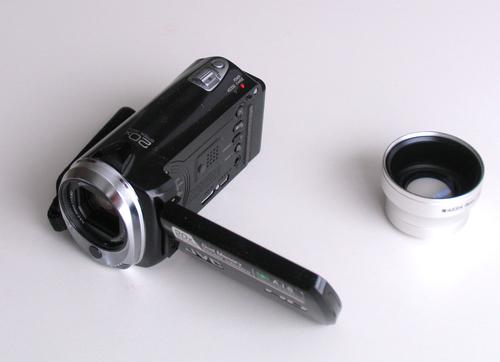 By march 2011, I figured, if I buy a camera mostly for video, maybe I should
buy an actual video camera. I found this JVC Everio camcorder relatively cheap.
The box said "full HD", but it turns out this one can only do 1080i (interlaced)
which is not ideal for computer video.
By march 2011, I figured, if I buy a camera mostly for video, maybe I should
buy an actual video camera. I found this JVC Everio camcorder relatively cheap.
The box said "full HD", but it turns out this one can only do 1080i (interlaced)
which is not ideal for computer video.
Overall, this camera was a disappointment. The widest it can zoom is 55 mm equivalent, far too narrow for my videos. I bought a cheap wide angle adaptor for it (only $16), but that wide angle adapter introduced some distortion, added bulk, and only brought it to about 35mm equivalent. The camera also gave me no control over white balance or exposure bias. Unlike the still cameras, this camera zooms silently while taking video. But that isn't much use to me. Even fully zoom ed out, it was still a bit too narrow.
I looked at some other camcorders. There are certainly better ones than this one. But I eventually concluded that camcorders are, ironically, poorly suited for the kind of videos that I make. I only used that camcorder for three videos.
A video shot with the Everio: Leaf vacuum trailer
Nikon Coolpix S6200
 In November 2011, I looked again at what cameras were available. For just over $100,
I bought a Nikon Coolpix S4100, which could do 720p video. But testing that camera,
the video was very poor quality. I returned the camera the same day, but this time
took a flash card with me to the store, and plugged it into the next model up, the S6200, and shot some test video
right in the store. The video quality was better than my Samsung, and the file sizes
also acceptable. The camera could zoom almost as wide. So I bought that one for $150 + tax.
In November 2011, I looked again at what cameras were available. For just over $100,
I bought a Nikon Coolpix S4100, which could do 720p video. But testing that camera,
the video was very poor quality. I returned the camera the same day, but this time
took a flash card with me to the store, and plugged it into the next model up, the S6200, and shot some test video
right in the store. The video quality was better than my Samsung, and the file sizes
also acceptable. The camera could zoom almost as wide. So I bought that one for $150 + tax.
A big drawback of this camera is the poor quality lens. For 720p video, that didn't matter that much, but for still pictures there was noticeable fuzziness in the picture. The audio also had quite a bit of hiss. The camera was also very slow, with a 2.5 second lag from pushing the button to actually starting video recording! That took some getting used to.
I used that camera for all my videos for two months, until I bought my next camera.
A video with the Nikon Coolpix S6200: Ice lensing
Nikon Coolpix S8200
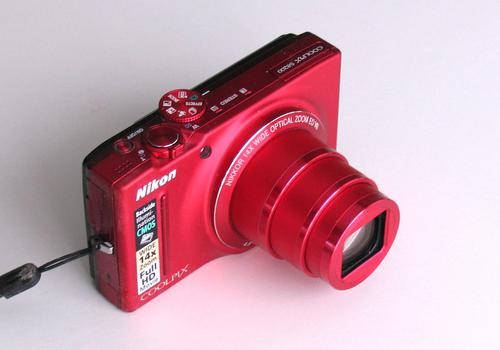 By January 2012, I looked at cameras again.
Once again, I took my flash card to the store. I shot some test video with various cameras,
then took the card home and had a good look at the video. Of the inexpensive cameras I tried,
the winner was the Nikon S8200. It could do decent 1080p video, and the audio was ok too.
At $250 + tax, I bought it.
The Canon cameras also take good video, but they still only
save the video as MJPEG. Once Canon adopts H264 or MP4 video formats, I will probably
buy a Canon again. The video quality of the Canon cameras is hard to beat.
By January 2012, I looked at cameras again.
Once again, I took my flash card to the store. I shot some test video with various cameras,
then took the card home and had a good look at the video. Of the inexpensive cameras I tried,
the winner was the Nikon S8200. It could do decent 1080p video, and the audio was ok too.
At $250 + tax, I bought it.
The Canon cameras also take good video, but they still only
save the video as MJPEG. Once Canon adopts H264 or MP4 video formats, I will probably
buy a Canon again. The video quality of the Canon cameras is hard to beat.
An annoyance with this camera is that when taking video it digitally zooms in by about 15%. The lens can zoom out to about 24 mm equivalent, but when taking video, the widest it shoots at is about 30mm equivalent.
The lens on this camera is a big improvement over the S6200. It's actually a very good lens for this class of camera. The 1080p video is good. It also shoots much better 720p than the S6200. Overall, I'm quite happy with this camera.
A video with the Nikon Coolpix S8200: Checking the jointer...
Nikon D5100
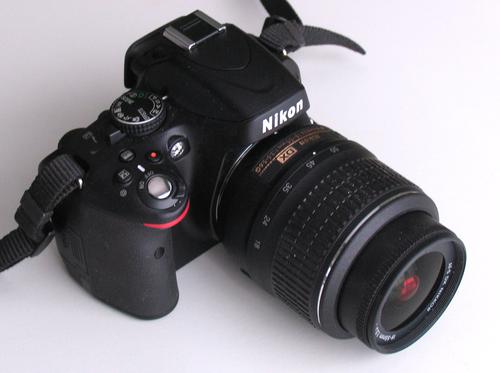 But in June of 2012, I finally bought myself a DSLR. This one's a Nikon D5100.
I didn't really have a good reason to buy it other than wanting a new toy. For
video, the S8200 is good enough, and for still pictures, it doesn't make that much sense
to take a big and fancy camera into a dusty workshop.
But in June of 2012, I finally bought myself a DSLR. This one's a Nikon D5100.
I didn't really have a good reason to buy it other than wanting a new toy. For
video, the S8200 is good enough, and for still pictures, it doesn't make that much sense
to take a big and fancy camera into a dusty workshop.
But I also wanted to experiment with taking video with a DSLR. As it turns out, the video quality from this camera is noticeably better than the S8200. The main drawback with using an SLR is that it's much easier to screw up a shot. Depth of field is very limited, and, from time to time, I found that my video was out of focus when I got around to editing it. That can be a big problem when the video is of a build - sometimes you can't go back and reshoot. Not that my other cameras don't suffer from the occasional miss-focus, but with the big lens of an SLR, miss-focus is much worse. Another issue is that the camera makes exposure adjustments with the aperture, and those tend to be in steps, so that causes noticeable flicker when the light levels change.
The audio has very little hiss, but it's also quite muffled - it sounds like it's been band-pass filtered. The camera has an external microphone jack. I later bought a Rode microphone for $200, but the audio quality was still poor. It seems it's the camera's internal circuitry that makes for poor audio quality.
A video with the Nikon D5100: Touring cottage #2
Nikon J3
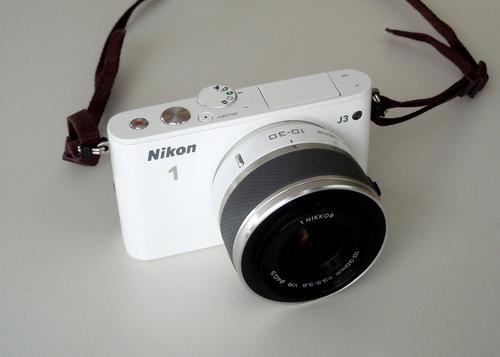 I bought a Nikon J2 when it was on clearance for $350 in April of 2013.
The video from that was quite good,
but, more importantly, the built in microphones are really good, and I can set the
recording volume, which means I can prevent the audio AGC from turning up the
background audio hiss. The J2 was my best camera for video so far, but, unfortunately,
I broke it. Looking around, I compared it with a mirorrless DSLR from Cannon, but,
once again, the file size from that camera was just huge compared to the Nikon, so
bought the J2 successor, the J3, this time at full price for $500.
I liked the J2 more than the J3, but video on the J2 is just as good. Audio on
the J2 was better though because it had forward facing microphones.
I bought a Nikon J2 when it was on clearance for $350 in April of 2013.
The video from that was quite good,
but, more importantly, the built in microphones are really good, and I can set the
recording volume, which means I can prevent the audio AGC from turning up the
background audio hiss. The J2 was my best camera for video so far, but, unfortunately,
I broke it. Looking around, I compared it with a mirorrless DSLR from Cannon, but,
once again, the file size from that camera was just huge compared to the Nikon, so
bought the J2 successor, the J3, this time at full price for $500.
I liked the J2 more than the J3, but video on the J2 is just as good. Audio on
the J2 was better though because it had forward facing microphones.
What I like about the J2 or J3 is that it's still fairly compact, and, not having a huge sensor like a DSLR, depth of field is less of a problem. The built in microphone is quite good, but it needs to be, because there's no microphone jack. I find that video files from the J3 don't work reliably with Sony Vegas (which I still use), so I now pre-process all video files with ffmpeg before editing.
An example of sound from the J2: "The audition"
Example video shot wit hthe J3: sharpening jig
The J3 is the winner at present. I'd recommend that camera for people wanting to take video.
Having said that, when I shot the video comparing all the cameras, I was once amazed at the video quality from the old Canon SD780 IS. so if you don't mind the very large file size from the Canons (on account of only using MJPEG compression), Canon cameras are hard to beat. but overall, I think most cameras have 1080p video that is good enough, but audio is often a problem. So if you shop for a camera for video, you should be paying more attention to audio than video quality.
 Lighting is just as important as what camera to use, and I often set up a
lot of lights for a shot, especially if it's a setup that I need to
shoot multiple clips with. For example this is the light setup for when I shot
my video on small table saw sled video.
The ligts are mostly regular lamps with 27 watt CF bulbs in them. The camera
on the tripod is my old S8200.
Lighting is just as important as what camera to use, and I often set up a
lot of lights for a shot, especially if it's a setup that I need to
shoot multiple clips with. For example this is the light setup for when I shot
my video on small table saw sled video.
The ligts are mostly regular lamps with 27 watt CF bulbs in them. The camera
on the tripod is my old S8200.
Video editing
For video editing, I use Sony Vegas. I use Platinum, version 11, but having seen earlier versions, I can positively say that there have not been any useful improvements to that software, at least none since around 2009. Sony Vegas is a very crash-prone piece of software. Once more than about 20 minutes of clips is imported from my Nikon cameras, it will run out of memeory and crash. The crashing is a function of the total length of clips imported, regardless of how much of those clips you actually use. I have found that converting all the files to mp4 using ffmpeg makes sony Vegas work much better. ffmpeg is a free command line tool, and I wrote some python scripts to automate processing of the clips. If you aren't familiar with little script programs, this is probably not a good choice for you. I'm sometimes asked what I'd recommend for a good and simple video editing solution. All I can say is, I know of no such solution, and I have tried most programs out there. I find most of them cumbersome and awkward compared to Sony Vegas, and Sony Vegas has many problems.
Addendum, 2014: I made a timelapse of when I shot the video to go with this article
More photography and video related articles:
 Brain Pick with Bob
Brain Pick with BobClagett interview
 Macro photography
Macro photographywith a cheap camera
 Simple light stands
Simple light standsfrom discarded lamps
Back to my Woodworking website
 Making the April Fools
Making the April Fools Shooting the TV show
Shooting the TV show Homemade tripod
Homemade tripod The steadycam you already own (but didn't know)
The steadycam you already own (but didn't know)
 Telescoping ceiling lamp
Telescoping ceiling lamp Window light diffuser
Window light diffuser LED vs CF
LED vs CF iPad tripod mount
iPad tripod mount